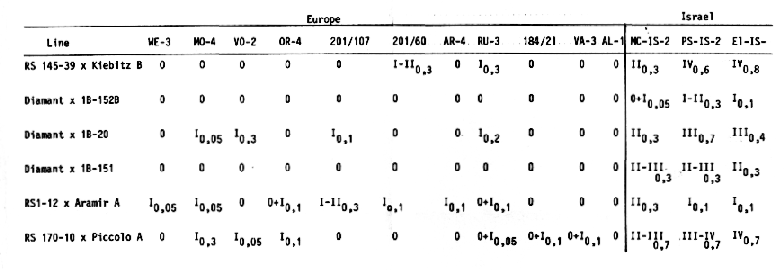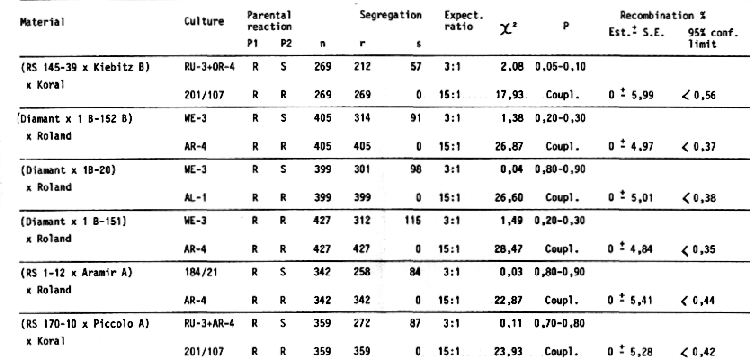

The powdery mildew of barley incited by Erysiphe graminis f. sp. hordei is one of the most important diseases in teperate climates. Wild barley (Hordeum spontaneum) and barley powdery mildew co-existed since many years in Israel (Harlan and Zohary, 1966; Wahl et al., 1978; Giles and von Bothmer, 1985). Fischbeck et al., (1976 a, 1976 b) have studied a large number of accessions collected from wild grown population of Hordeum spontaneum in Israel. Moseman (1971) and Moseman et al. (1983) reported about the use of H. spontaneum as a donor for mildew resistance in barley breeding. A total of 42 barley lines derived from H. spontaneum have been studied. The alleles M1-a16, M1-a17, M1-a18, M1-a19 of the M1-a locus have been identified and a new locus for powdery mildew resistance M1-i has been found in the line 'RS 42-8 × Oriol A' and localized. These results were presented in Barley Genetics Symposium, Okayama by Jahoor and Fischbeck (1987 a). Furthermore, in the 6 barley derived lines the mode of inheritance and resistance spectra have been studied. Total of 32 barley varieties or lines have been included in these studies to verify whether the resistance spectra of the derived lines are different from the resistance patterns of the known mildew resistance genes. The detailed resistance spectra of known genes are given elsewhere (Jahoor, 1987). Fourteen powdery mildew cultures were used in the mildew tests. The reaction patterns obtained on the 6 derived lines are given in Table 1. European isolates bring out mostly high resistant type of reaction with exception of isolate 201/60 on line RS 145-39 × Kiebitz B. Infection with mildew cultures from Israel were obtained all possible types of reactions. These results and earlier observations of Jahoor (1987) and Jahoor and Fischbeck (1987 b) with known resistance genes showed that the patterns of resistance of these derived lines are different from the spectra of resistance of the known resistance genes.


Crosses between the H. spontaneum derived lines and European cultivars such as 'Koral' and 'Roland' possessing M1-a13, M1-a9 resistance gene respectively were carried out (Table 2). This segregation relationship shown in Table 2 indicates the presence of a dominant gene for mildew resistance. Tests for allelism with the M1-a locus were carried out with suitable mildew cultures. No recombinant plants were found in these test crosses. Thus, the mildew resistance genes in these derived lines are located on the M1-a locus or these genes are very closely linked with the M1-a locus. The upper 95% confidence limit of recombination was estimated by the method described by Giese et al. (1981) which are ranging between 0.35 and 0.56% cross over unit (Table 2).
The reaction with Israeli cultures of powdery mildew given in Table 1 identify two new alleles on the M1-a locus. These alleles are different in their patterns of reaction from the previously identified 19 alleles of this locus. It is suggested that these alleles in the lines 'RS 145 - 39 × Kiebitz B' and 'Diamant × I B - 152 B' should be designated as M1-a20 and M1-a21 respectively.
It cannot be established from these results, whether the minor modifications in the resistance spectra of the remaining 4 lines in Table 1 are due to genetic background, or whether these lines possess different resistance genes. Further mildew tests are needed to verify these assumptions.
References:
Fischbeck, G., Schwarzbach, E., Sobel, Z. und I. Wahl. 1976a. Mehltauresistenz aus israelischen population der zweizeiligen Wildgerste (Hordeum spontaneum). Z. Pflanzenzucht. 76:163-166.
Fischbeck, G., Schwarzbach, E., Sobel, Z. and I. Wahl. 1976b. Types of protection against barley powdery mildew in Germany and Israel selected from Hordeum spontaneum. Barley Genetics III, Proc. 34d. Int. Barley Gen. Symp., 412-417.
Giles, B. E. and R. von Bothmer. 1985. The progenitor of barley (Hordeum vulgare ssp. spontaneum) - its importance as a gene resource. Sveriges utsadesforenings Tidskrift 95, 53-61.
Harlan, J. R. and Zohary. 1966. Distribution of wild wheats and barley. Science 153:1074-1080.
Jahoor, A. 1987. Mehltauresistenz aus israelischer Wildgersten- Resistenz-spektrum, Vererbung und Lokalisierung. Diss. Fakul. f. Landwirtachaft und Gartenb. der TU München, 199 p.
Jahoor, A. and G. Fischbeck. 1987a. Localization of resistance genes against powdery mildew in Hordeum spontaneum C. Koch. Barley Genetics 1V, Proc. 4th Int. Barley Genetics Symp., Okayama (in press).
Jahoor, A. and G. Fischbeck. 1987b. Sources of resistance to powdery mildew in barley lines derived from Hordeum spontaneum (in press).
Moseman, J. G. 1971. Coevolution of host resistance and pathogen virulence. Barley Genetics II, Proc. 2nd Int. Barley Genet. Symp., Pullman, Washington, 450-456.
Moseman, J. G., E. Nevo and D. Zohary. 1983. Resistance of Hordeum spontaneum collected in Israel to infection with Erysiphe graminis hordei. Crop Sci. 23:1115-1119.
Wahl, I., N. Eshed, A. Segal and Z. Sobel. 1978. Significance of wild relatives of small grains and other wild grasses. In: Cereal Powdery Mildews. In: The Powdery Mildew (D. M. Spencer, ed.), Academic Press London, 83:100.